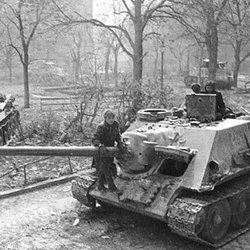The SU-100 (Samokhodnaya Ustanovka 100) was a tracked Soviet tank destroyer armed with a massive 100 mm anti-tank gun. The tank originated through the simple need from the Soviet Army needing to combat the latest generation of German tanks now being fielded across the Eastern Front. Soviet engineers responded by developing a new mobile gun platform based around the existing B-34 naval gun utilized on Soviet warships. The SU-100 was used most during the last year of World War II and saw service for many years afterwards with the armies of Soviet allies around the world.
Closely related to the SU-85, the SU-100 incorporated much of its design, revolving around the new D10 100 mm (3.94 in) antitank gun. A well-trained and experienced crew could loose up to six rounds per minute. The SU-100 was developed from the chassis of the T-34 tank replacing the turret with a larger, fixed superstructure that allowed a larger gun to be fitted. The larger cannon was effective, being able to pierce 4.72 in armor at up to 2187 yards and the sloped 3.35 in frontal armor of the German Panther tank at 1640 yards.
Development was conducted under supervision of L. I. Gorlitskiy, chief designer of all medium Soviet self-propelled guns. The work started in February 1944 and the first prototype of the SU-100, “Object 138”, was delivered in March. After testing different models of 100 mm guns, Soviet engineers approved the D-10S gun for mass production. This gun was developed in Constructors Bureau of Artillery Factory No. 9 under the guidance of F. F. Petrov. The gun was installed onto a specially engineered mount that made for a rather complex overall system. 33 x 100mm projectiles were typically carried on a given SU-100 and this was usually divided into a standard issuing of 18 x AP (Armor-Piercing) rounds and 15 x HE/FRAG (High-Explosive / Fragmentation) rounds allowing the SU-100 crew to tackle both “hard” armored and “soft” targets. High-explosive ordnance proved highly effective when engaging concentrations of dug-in troops and light-armored vehicles. Interestingly, no thought was given to arm the SU-100 crew with self-defense machine guns – making her susceptible to both enemy infantry attacks and low-flying aircraft. After the Second World War the 100mm gun was installed on T-54 and T-55 tanks and continued to be used in service forty years after initial development.
The hull of the SU-100 had major improvements over the SU-85; the thickness of the front armor was increased from 1.8” to 3.0”, and the commander’s workplace was made in a small sponson on the right side of the hull; combined with the commander’s cupola this slightly improved the commander’s effectiveness to see the battle space (barely effective as is). Mass production of the Su-100 began in September 1944. By July 1945, 2,335 SU-100s had been built.
The SU-100 saw extensive service during the last year of the war. It was used en mass in Hungary at the Eastern Front in March 1945. There Soviet forces defeated the German Operation Frühlingserwachen (Operation Spring Awakening) offensive at Lake Balaton (where the last oil reserves for the Axis were located). This was Germany’s last major offensive of WWII. This offensive was referred to in Germany as the Plattensee Offensive and in the Soviet Union as the Balaton Defensive Operation. The battle lasted from March 6th to 15th, 1945.
The vehicle remained in service with the Red Army well after the war; production continued in the Soviet Union until 1947 and into the 1950s in Czechoslovakia. It was withdrawn from Soviet service in 1967 but many vehicles were transferred to reserve stocks. Some still remain in the Russian Army holding facilities.
Many Warsaw Pact countries also used the SU-100, as did Soviet allies such as Egypt, Angola and Cuba. A few SU-100 were delivered to Yugoslavia after the war, under the designation M-44. SU-100s entered service with the People’s Liberation Army (PLA) of China after 1 December 1950 when Soviet forces left Dalian. The armaments in Dalian were sold to China, including 99 SU-100s, 18 IS-2 heavy tanks, and 224 T-34s, with which PLA formed its 1st Mechanized Division. The SU-100 saw service in the fighting that accompanied the 1956 Suez Crisis, in which the Egyptians used SU-100s against Israel’s M4 Sherman tanks. The vehicle was also utilized in the 1967 Six-Day War and the 1973 Yom Kippur War. It was modified slightly to adapt it to the sandy conditions of the Middle East, thus creating the SU-100M variant. Exported SU-100s continued in service until the 1970s, and in some countries, even later. Yugoslavs used them during the civil war; however, due to lack of spare parts they were quickly retired, despite their satisfactory performance. The SU-100 remains in use by the Vietnam People’s Army and the Korean People’s Army Ground Force. Testament to the SU-100’s longevity, in April 2015, a SU-100 self-propelled gun was photographed being used in Yemen as part of the ongoing conflict.





